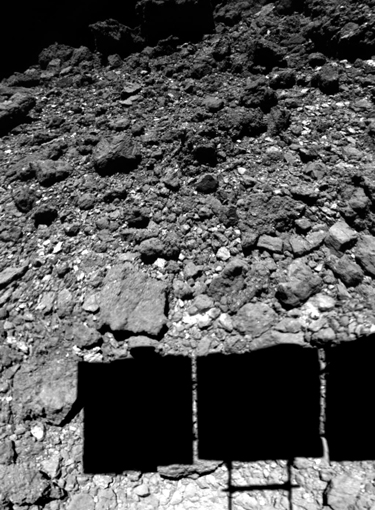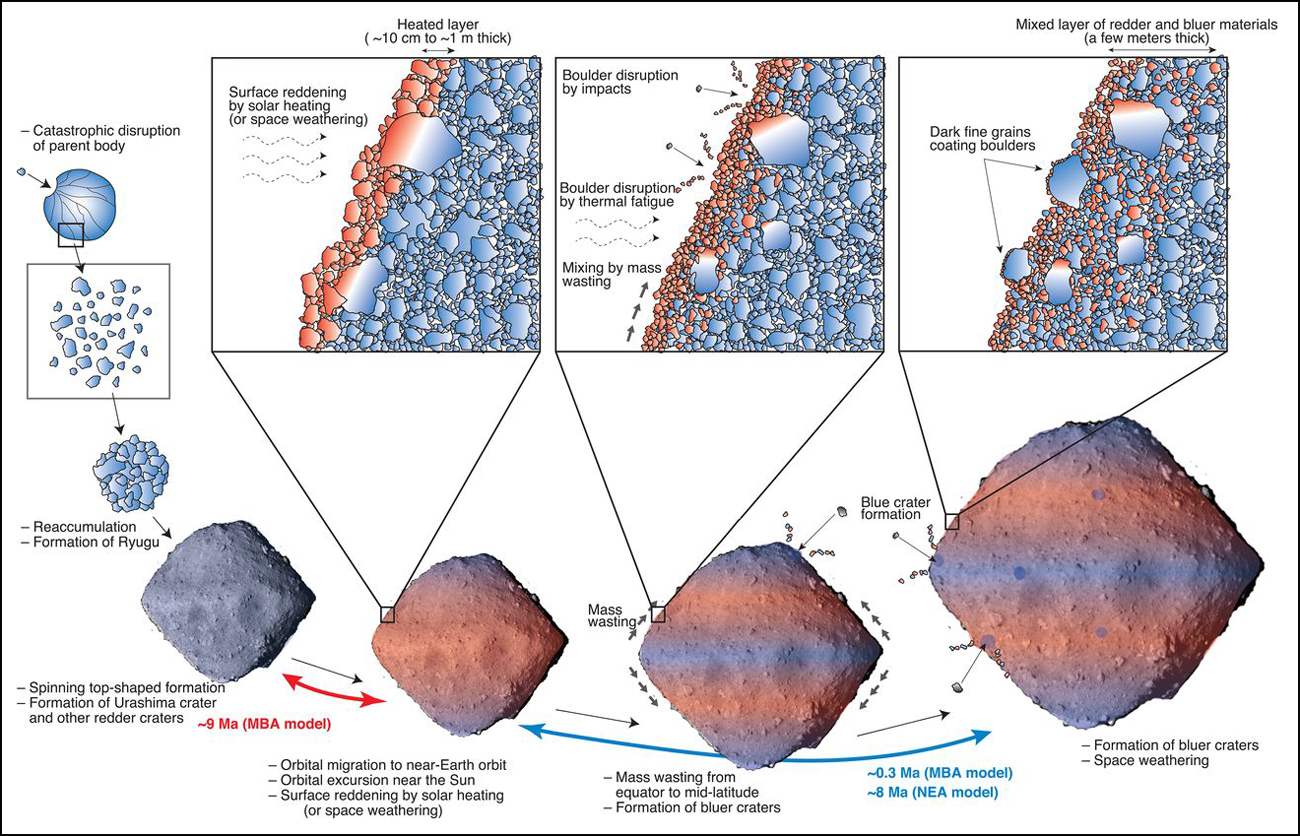Apparently, even asteroids can get sunburns.
Newly analyzed high-resolution images from the Hayabusa2 landing on the near-Earth asteroid Ryugu revealed a reddish hue to surface materials. Scientists interpret that coloration to be a result of a brief orbital excursion close to the Sun. When combining this information with previously collected data from Ryugu, scientists can now paint a clearer picture of how and when the asteroid formed, how its orbit has changed over time, and what its surface looks like.
Learning About an Asteroid

The Japan Aerospace Exploration Agency’s (JAXA) spacecraft Hayabusa2 took off for Ryugu in 2014. It arrived in orbit in 2018 and touched down on the asteroid in February 2019 to collect samples for a return to Earth, which will occur later this year. Data from Hayabusa2 have been steadily painting a clearer picture of the asteroid while also revealing surprises at every turn.
Ryugu is 900 meters in diameter and shaped like a spinning top. It is a carbonaceous asteroid, the most common type of asteroid known. Although scientists won’t know for certain until samples return to Earth, they think Ryugu is likely to contain hydrous forms of minerals. The asteroid is covered in highly mobile pebbles and multimeter boulders but no soft dust.
In the latest study on Ryugu, published in May in Science, Tomokatsu Morota of the University of Tokyo and colleagues reported that the asteroid’s surface is very young, is “black like coal with a slightly reddish tint,” and “has lower surface gravity than many other planets and small bodies.” These and other characteristics had previously been reported by scientists studying Ryugu: its rubble pile nature, the presence of some hydrous minerals, and similarities to some carbonaceous chondrite meteorites found on Earth. Together, these features “suggest that Ryugu was formed by accumulation of fragments ejected from a primitive or dehydrated carbonaceous parent asteroid by an impact,” Morota said. In fact, the team reported, it may have formed from several cataclysmic events.
“We were surprised to see that the subsurface material was darker than the surface material.”
But perhaps the most interesting part of the recent findings is the asteroid’s color. “We were surprised to see that the subsurface material was darker than the surface material,” said Makoto Yoshikawa, Hayabusa2 mission manager at JAXA.
Ryugu’s subsurface was revealed as Hayabusa2 touched down and its thrusters lifted particles in the subsurface layer. The particles were dark black with a reddish tint, whereas the surface was bluer. Ryugu’s boulders also tended to be bright and blueish with sporadic reddish singeing on top. Surface coloration varied by latitude, with bright rocks at the equator and poles and reddish materials at midlatitudes.
Coloration was also revealed as Hayabusa2 shot a tantalum bullet into the surface to make an artificial crater and collect the ejecta for the sample return mission. A boulder that broke in the procedure was found to be 1.5 times brighter inside than out.
The strange coloration hints at two important findings: the asteroid’s young age and its changing orbital history.
Thermal Metamorphism
Potential causes for the coloration include pummeling by small impacts, exposure to space weather, and heating by the Sun. Scientists concluded that solar heating is the most likely reason for the red coloring: The reddish materials were several meters deep, but space weathering usually affects only the top 100 nanometers of surface materials, and there are not enough craters or other evidence to indicate significant pulverization by small impacts.
Basically, Ryugu got a sunburn.
The team used size frequency distributions of blueish to reddish craters to estimate that Ryugu’s surface reddening occurred between 0.3 million and 8 million years ago, Morota said, whereas the asteroid itself is estimated to have formed between 8.8 million and 16.6 million years ago. The dating suggests that Ryugu spent 8.5 million years in the main asteroid belt and between 300,000 and 8.1 million years in near-Earth orbit. As it shifted orbits, it came near enough to the Sun to be physically impacted by solar heat. This proximity probably lasted less than 1 million years, Morota said.
Basically, Ryugu got a sunburn, Yoshikawa said.
“The conclusion—that Ryugu must have approached the Sun close to the orbit of Mercury—is very interesting,” Yoshikawa added, “because while we know that theoretically such an event is possible, this paper shows that such a thing really happened in the past.” But, he noted, the team will learn much more once they get the samples back later this year.

Comparative Analysis
Learning about asteroids like Ryugu and Bennu, another carbonaceous asteroid from which the NASA Origins, Spectral Interpretation, Resource Identification, Security, Regolith Explorer (OSIRIS-REx) mission will collect samples later this year, is important for understanding how our solar system evolved.
Moreover, such asteroids “contain natural resources such as water, organics, and precious metals,” which might, “in the future, fuel the exploration of the solar system by robotic and crewed spacecraft,” said Grey Hautaluoma, a NASA spokesperson.
It will be interesting to compare the results from these two missions, Yoshikawa added. “Then I think we will get better understanding of the evolution of small near-Earth asteroids.”
—Megan Sever (@MeganSever4), Science Writer
Citation:
Sever, M. (2020), Sunburned surface reveals asteroid formation and orbital secrets, Eos, 101, https://doi.org/10.1029/2020EO145163. Published on 05 June 2020.
Text © 2020. The authors. CC BY-NC-ND 3.0
Except where otherwise noted, images are subject to copyright. Any reuse without express permission from the copyright owner is prohibited.

